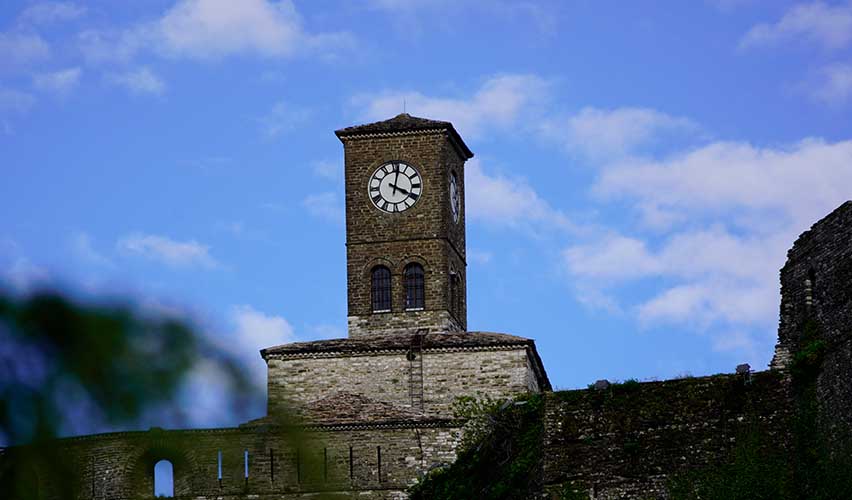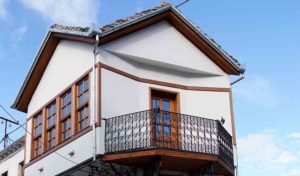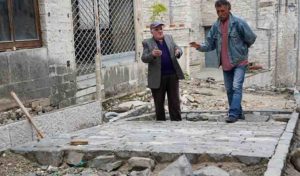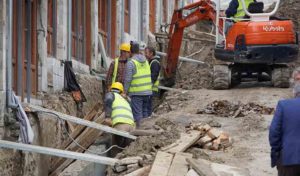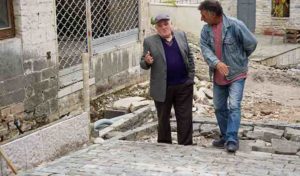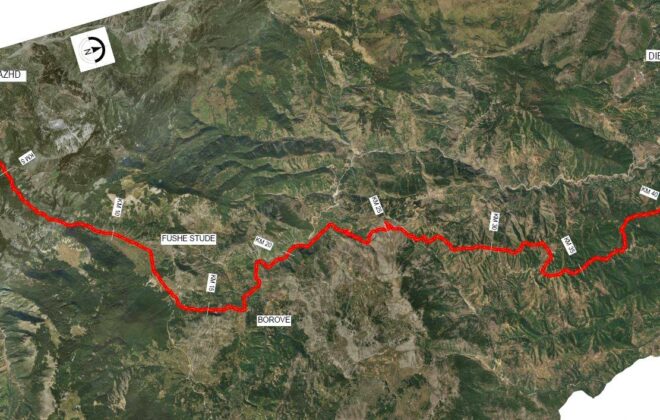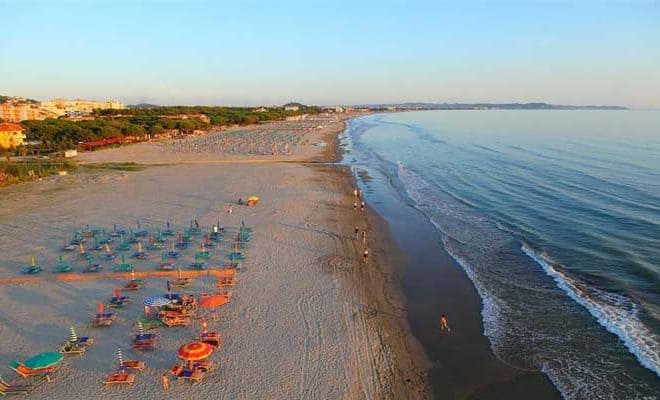Gjirokastra cultural heritage in front of tourism development challenges
The Old Bazaar of Gjirokastra wakes up slowly by the sound of masters hammers working for the reconstruction of old houses. The latter will be the new guesthouses which will welcome tourists from all over the world.
Dielli i këtij mesprilli nuk ka kaluar ende mbi Kullën e Sahatit të kalasë hijerëndë, por aroma e petullave të mëngjesit që të përkëdhel flegrat dhe tymi i oxhakëve të tregojnë se brenda shtëpive të qendrës historike dita ka filluar me kohë.
The sun of these mid-April days has not passed over the Sahat tower of the stately castle, but the smell of morning pancakes and the smoke of chimneys show that the day has begun earlier in the houses of this historic center.
May is the month where come the first busses with tourists. Last year the number of tourists exceeded 150,000. This year the season started a month earlier. Promotion in social networks, foreign media specialized in tourism and travel has yield positive results. The number of tourists and visitors is expected to grow more and more. At the same pace will grow even the demand for accommodation and services. As a result, investments are encouraged, especially in the historic center. Most tourists prefer to stay there claiming that this is their favorite area. If you stay there you have fast access to cultural monuments such as Skendulate House, Babameto Tower and the stately castle.
Nëse shkon sot në Gjirokastër dhe viziton qendrën historike, te Qafa e Pazarit do të gjesh një kantier ndërtimi. Fondi Shqiptar i Zhvillimit po punon për rikualifikimin urban dhe restaurimin e kalldrëmeve në Qafën e Pazarit. Ndërhyrja po kryhet në kuadër të projektit “Për Zhvillimin e Integruar Urban dhe Turizmin” që financohet nga qeveria shqiptare dhe Banka Botërore. Rrjeti inxhinierik nëntokësor po ndërtohet nga e para dhe pas tij do të vazhdojë restaurimi i 6,000 metrave katrorë kalldrëme dhe rehabilitimi i mbi 900 metrave katrorë hapësira publike. Kur i qasesh pazarit nga sheshi i Sheshi i Çerçizit një tabelë në hyrje tregon se investimi në total është rreth 1 milionë Euro.
The cobblestone dismantling process has first started with its detailed documentation and stones in good conditions have been stored carefully. In the site you hear the sound of the machineries and you see workers who work for the construction of the water supply system, lighting system, telephony network and fiber optics, sewage network, manholes, etc. “The entire underground engineering network will be built from the beginning,” says Pavli Mico, engineer of the Albanian Development Fund managing the contract for this project. This part of the city has never had a genuine engineering network, but now the businesses of this area, tourists and visitors need contemporary services.
Franco an Italian tourist and his English friend have learned about Gjirokastra from social networks. "I'm trying to take a photo of this wonderful building, but these wires spoil the photo,"Franco says, while laughing and taking photos from all the corners of the building that has become the symbol of Qafa e Pazarit Quarter.
The urban requalification and the restoration of cobblestone aim to create a new model of development projects in the country. It is integrated with the project of restoration interventions on facades and roofs of buildings in this area. This project was completed last year and was funded by the Albanian-American Development Foundation (AADF).
Prior to and during project implementation, the Albanian Development Fund was consulted with KfW, which plans to finance the construction of water supply in Gjirokastra. “We have been consulted with all institutions that plan interventions in this part of the city. We aim to build a network that matches any other project that is being planned in the future,” says Mico.
Ideja është e thjeshtë: të shmanget ajo që ka ndodhur rëndom me investimet në infrastrukturën rrugore kur një rrugë e saposhtruar hapet sërish për të kryer investimin ujësjellësi, kompania e telefonisë, etj. “Kalldrëmet u hapën që të punohet në të gjitha drejtimet dhe në bashkëpunim me të gjithë aktorët e mundshëm, në mënyrë që kur të shtrohen të mos hapen sërish,” thekson Miço.
By February, civil works were interrupted because of the snow. “But since the end of February works advanced at a fast pace. Workers now are working for the underground engineering network and after concluding this step will proceed with cobblestone,” says Mico. He adds that the pressure from businesses and locals to advance with work is huge and understandable. "In addition to a historic area, Old Bazaar is also a business and service center and is the main source of income for many residents. On the other hand, locals love Old Bazaar as it was. We are working to finish works not only in time but above all with quality."
The existing stones will be used for the main axes of the Bazaar Roads starting from the Hazmurat neighborhood, Cerciz Square, the castle and District Council. "A part of the cobblestone has been damaged over the years from vehicles. In order to replace these stones we have carried out some analyzes. We found the same stone in Mashkullore, "says Pavli Mico.
Many public consultations were organized in different phases, thus all interested parties can express their concerns and reflect the respective solutions. Dorjan Llogo a representative of the business association in TID area, in the historic center, emphasizes that this investment is vital. We have the guarantee for the quality of the works with the involvement of the ADF as the implementing agency.
"The rehabilitation of facades and roofs together with this project are two integrated projects. We have followed it closely and raised a number of issues that were considered problematic. These issues were resolved. This experience is quite different from previous experiences. If there is a stakeholder who is interested in the project progress, this is the business group," says Llogo.
Public investment has been an excellent incentive for private investment. Only in 2018 in the Old Bazaar area, were invested 2 million Euro by private entrepreneurs. “This money is invested only in TID zone, which does not represent the whole Old Bazaar. In 2019, were built two new hotels and other accommodation capacities are in progress. In addition to this, there are also other small businesses such as restaurants, etc. Foreign tourists like to visit this city. Now we are targeting local visitors and extending tourism season even in winter.”
Llogo claims that works should be completed as soon as possible, in order to minimize the damage to businesses.However, the conclusion of the works for the engineering network will mark the end of the most critical phase of the project in terms of visual impact on residents, businesses, tourists and visitors. Upon completion of the engineering network and sidewalks, and removal of inert waste, the process of cobblestone can continue normally. Cobblestone works can be considered a tourist attraction for visitors, "says Llogo.
Cobblestone in Qafa e Pazarit Quarter-Much ado about nothing
The cobblestone dismantling had many reactions on social networks and from locals. Social networks came to the conclusion that the cobblestone was destroyed by the dismantling process while locals were reserved about this situation.
“It is a necessary investment, but we want the cobblestone as it was before and as soon as possible,” says Irena, who has rented a small shop at Qafa e Pazarit Quarter, where she sells souvenirs and provides clock repair services.
In fact, the concern of locals is not unjustified. Prior to this investment, the cobblestone was restored, but the work done was not qualitative. For residents of Gjirokastra quality is the first.
"The cobblestone does not require beautiful lips, but strong këllqe(duhet pershtatur shprehja Kalldremet nuk duan buze te bukura por kellqe te forta)”says Drini Gjoni, one of the cobblestone and plaster masters. He has started at age. Babameto house, Veizi path and many other buildings in the historical center has his seal.
Drini is part of the group of workers contracted for cobblestone. While engineers take care that the pipes have the right material, the right radius, and are positioned in the right place, Drini takes care that the cobblestone base is strong and its stones are connected to the right materials to resist time, using the same techniques as old masters did.
"The cobblestone foundation should be strong and well-compressed. The cobblestone roads in this quarter are in the shape of a fishback, meaning that the road is higher at the midline and lower at the sides, thus rainwater goes on one side and pedestrians walk comfortably without feeling sloping.""Once we are assured that the base is strong, we begin with the stones. The secret of the stone connection is the sand," says Drini, who knows very well where to find the sand used in the 60s and '70s.
In order to avoid any possible mistake he always discusses with his teacher and at the same time colleague Spiro Bezhani, alias "Papu Pilo". Papu Pilo has an experience of 33 years with cobblestones and he knows all secrets.
“I have seen some concluded work and it looks good. If we proceed like this would be a great work. Concerned about the issue, I have gone 2-3 times to the site to see and suggest. Also, I have suggested how to put the spangles to facilitate the work, "says Papu Pilo.”
One of the concerns expressed for cobblestones is the lack of engagement of local masters. Papu Pilo is probably the only one who is still active. Other masters, as he says, are either too old or have died.
The youth do not like this job. There were those who were trained by some foreign organizations, but they cannot be engaged in restoring this cobblestone. They are not ready yet. The cobblestone needs experienced people who know the cobblestone secrets, "says Papu Pilo.
The story of the cobblestones does not end there. They also carry many other secrets. But that's another story.
“ Laureta Spahiu
Fondi Shqiptar i Zhvillimit “


